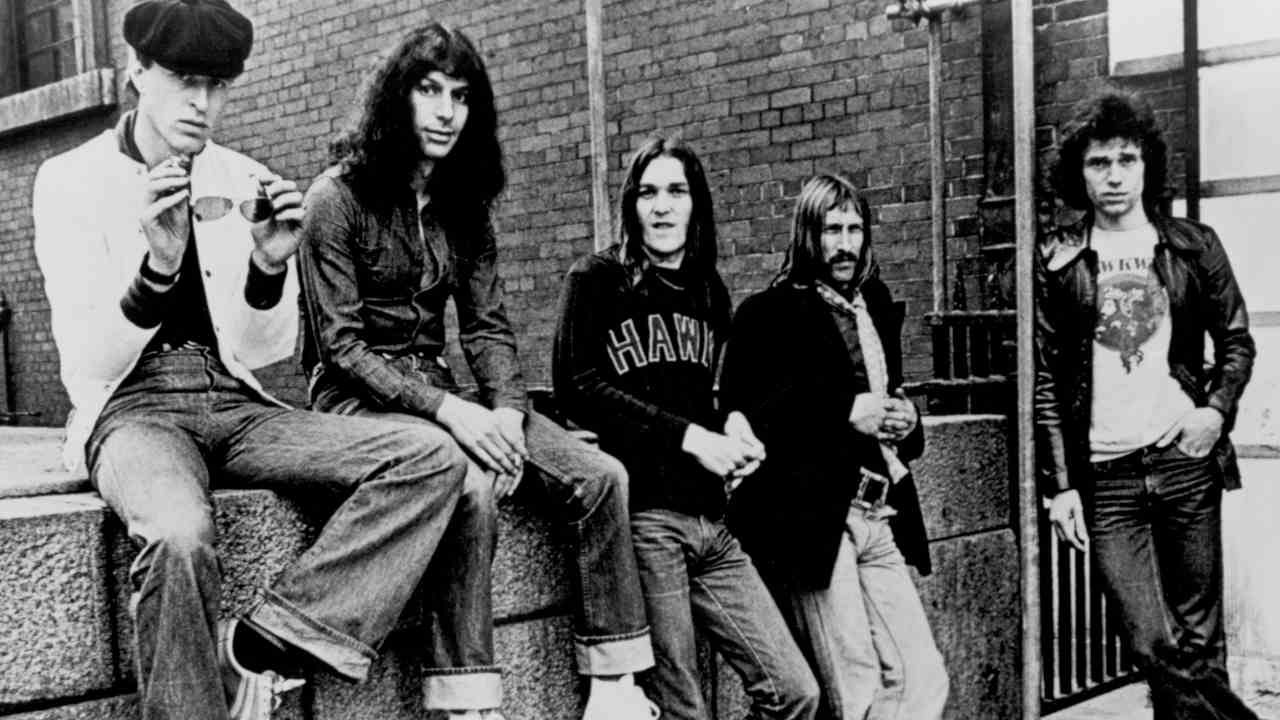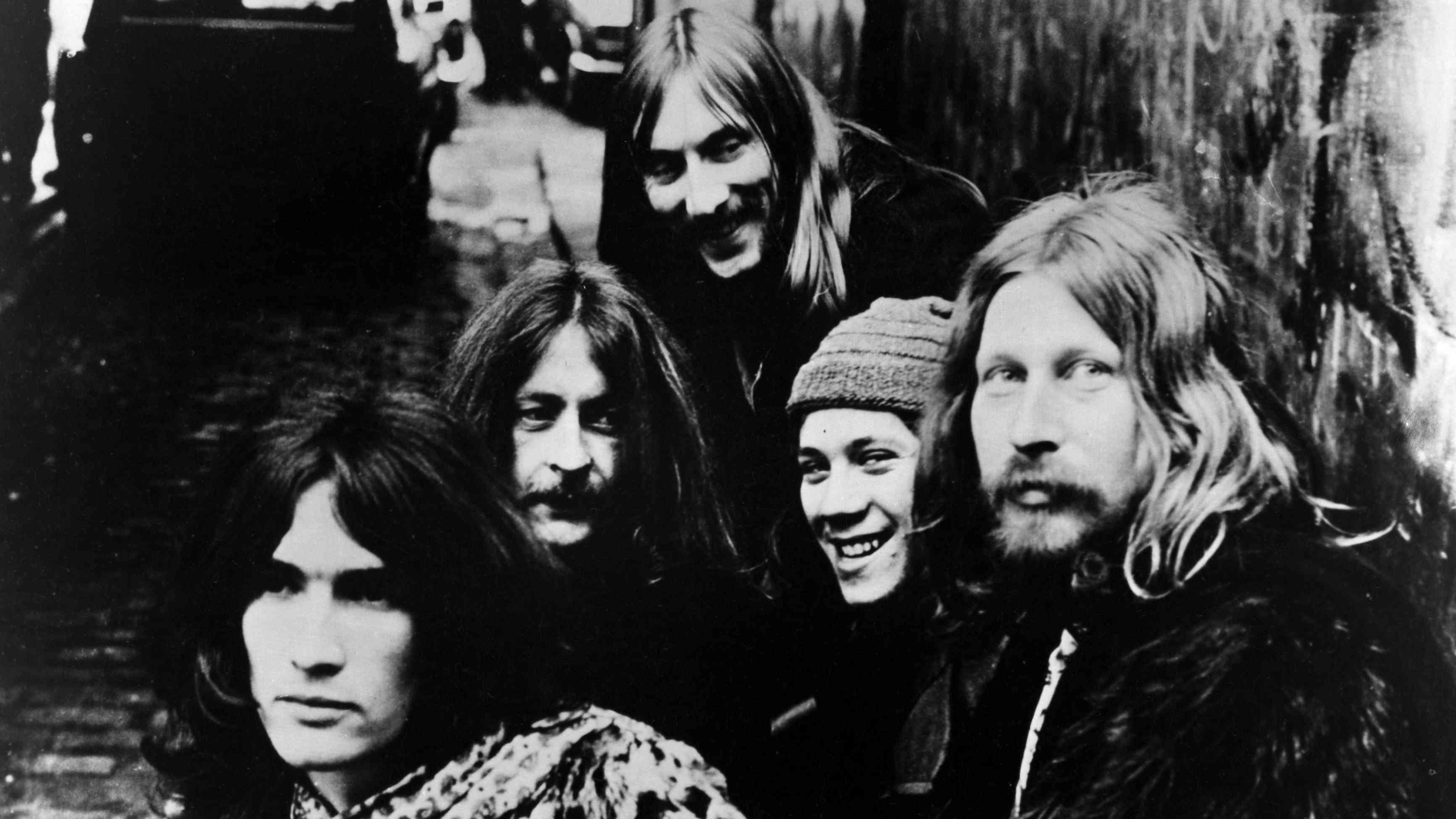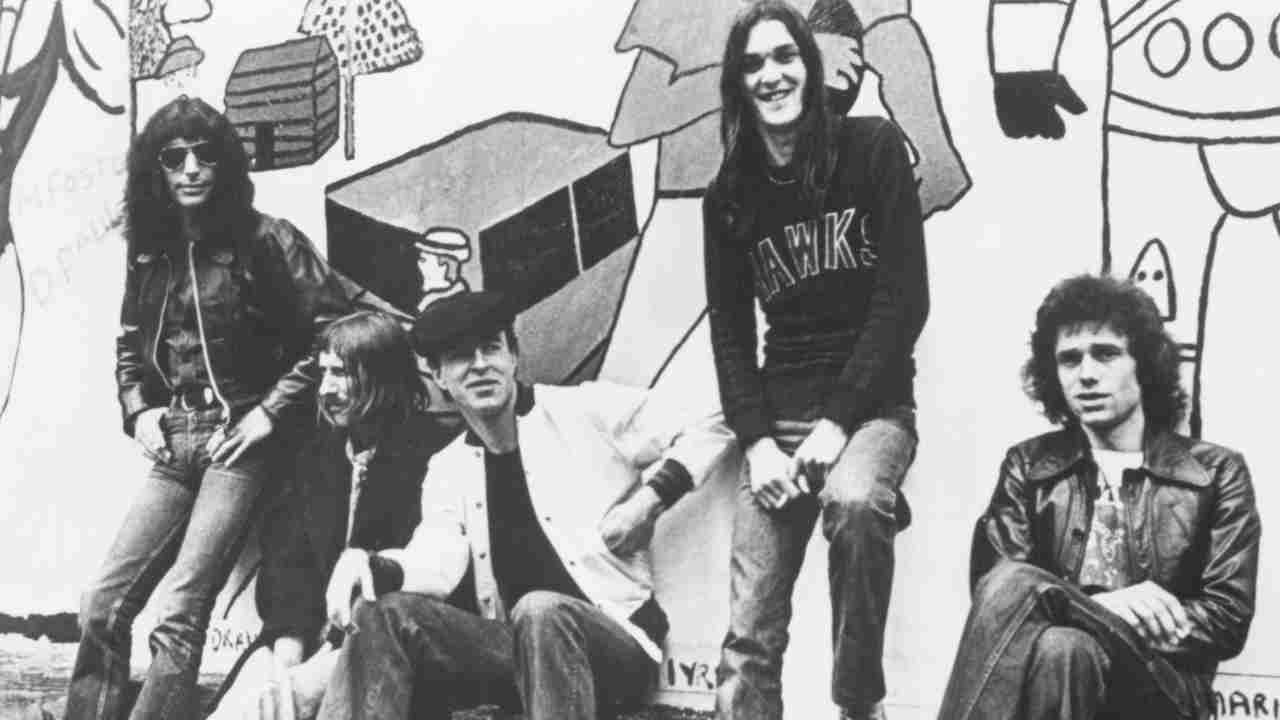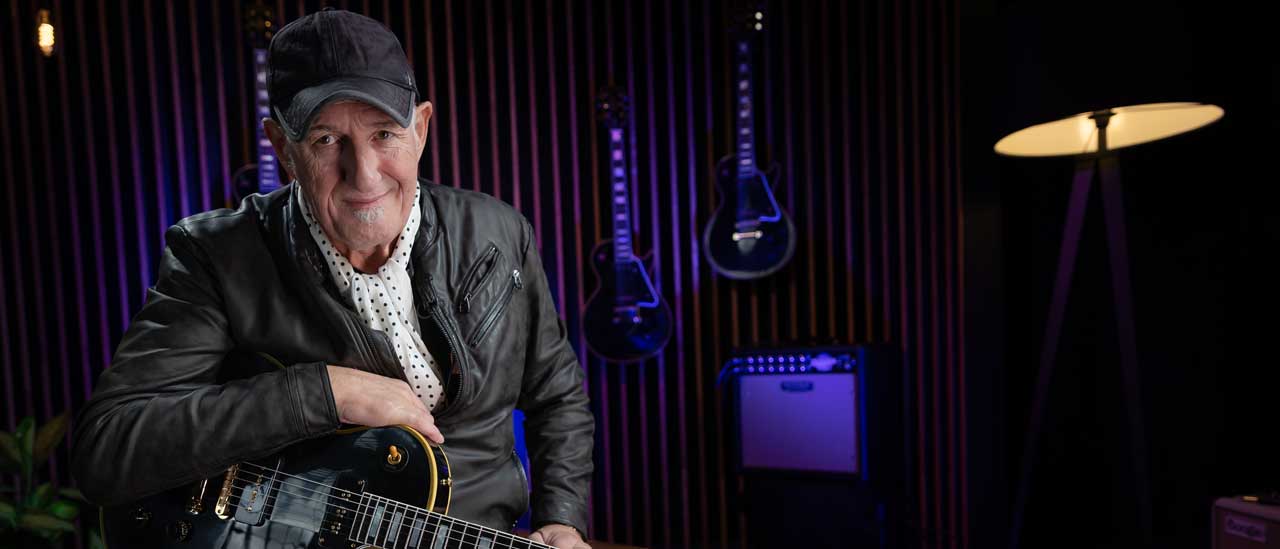“We were the belt-and-braces Pink Floyd – basic yobbos”: how Hawkwind boldly went where no band had gone before on psychedelic masterpiece In Search Of Space
America had hippies and Woodstock – the UK had greasy, gritty space-heads Hawkwind and their cosmic epic In Search Of Space

Since they formed at the end of the 1960s, Hawkwind have been flagbearers for the British underground psychedelic scene. In 2011, journalist and musician Mick Farren – former frontman with their late 60s contemporaries The Deviants – looked back on Hawkwind’s breakthrough second album, 1971’s In Search Of Space.
Although the teepee was constructed from tarpaulins and scaffold poles, it looked authentic from a distance, as though Sitting Bull might be its occupant rather than Nik Turner and Terry Ollis. Hawkwind’s camp at the first Glastonbury Fayre was next to the big, green, M.A.S.H.-style tent shared by The Pink Fairies, the IT/Oz/Friends underground press triumvirate, and Ladbroke Grove notables like Little Tony and Eric the Tramp. The two disreputable tents, at the crest of the gentle slope that ran down to the amazing Pyramid Stage, housed the kick-ass urban freaks down from the big, dirty city, who posed a distinct contrast to the rustic hippies in the mists of Avalon.
By day, a large red Soviet naval flag flew from a makeshift tent pole, both as a gesture of defiance, and so the stoned and disorientated could find their way home. At night we created the largest and most impressive fire in the whole free festival, a pagan circle where drink and drugs circulated freely while potential sex partners eyed each other through the flames.
It was wild and idyllic, but a feeling nagged at the edges that this was the end of an era. It was 1971, not 1967, and the Summer of Love was long gone. Times were hard and attitudes were hardening. In the world at large, the Vietnam War dragged on, as did the troubles in Northern Ireland. Charlie Manson and three of his girls had been sentenced to death in Los Angeles. At home Edward Heath was Prime Minister, the Tories were in power, and the British economy was floundering. Heroin was replacing hash as the drug of choice. Former flower children were mindless on Mandrax. A week after that first Glastonbury Fayre folded its tents, Jim Morrison died, allegedly in a Paris bathtub. Even Hawkwind would go through changes. Before the year was out they would have an album in the UK chart.
A year earlier, Hawkwind had made a counterculture reputation for themselves by joining The Pink Fairies to perform for free on the campsite at the chaotic 1970 Isle of Wight festival as The Who, Jimi Hendrix and the Doors were paid fortunes to play the main stage, and anarchists, Hells Angels, White Panthers and undefined malcontents tore down fences and burned customer-gouging hot dog stands. The partnership between the two bands dubbed themselves Pinkwind, and the unconventional double act played benefits at the Roundhouse and hit-and-run guerrilla shows under the echoing arches of London’s newly constructed Westway. None of this community-based, take-no-prisoners rocking out seemed, at any stretch of the imagination, like a career path that would ultimately take Hawkwind to Top Of The Pops.
At the same time as all of the psychedelic rebel frolics, Hawkwind were also recording their second album, In Search Of Space. According to legend (and Wikipedia) the first session took place at George Martin’s AIR Studios, but this high-tech, upper-class domain of The Beatles’ producer supposedly proved too straight-laced for renegade Hawklords. “After a week,” Wiki tells us, “with little to show for their effort, the studio engineers were reluctant to work with the band after reports that friends of the band broke into George Martin’s drinks cabinet, pinched all his booze, and spiked the engineers with acid.”
Remembering events from decades ago is not easy at the best of times, and these Hawkwind sessions seem to be a more specific version of actor/activist Peter Coyote’s remark about the 1960s: if you could remember the recordings you probably weren’t there. None of the principals in the making of In Search Of Space recall any booze stealing or acid spiking – or maybe they wanted to draw a veil over possible shenanigans at AIR. Guitarist and band founder Dave Brock remembered: “All the engineers at AIR seemed to think they were the producer. But when we moved over to Olympic – the studio the Stones used – and George Chkiantz was in charge, everything started to work out.”
Sign up below to get the latest from Classic Rock, plus exclusive special offers, direct to your inbox!
Nik Turner recalls that the search for space wasn’t exactly easy: “I can remember being in the studio. I remember sleeping on Barney Bubbles’s floor and being involved with him working on the cover and posters and stuff, and Dave Brock and Dave Anderson both saying: ‘I’ve got this song. Have you got some lyrics for it. It’s called Masters Of The Universe. And then Brock and Anderson were fighting over who wrote the riff, and Brock turned round and sacked Dave Anderson from the band.”

By 1971, Olympic Studios – a converted Edwardian cinema in Barnes, South London – was already a rock’n’roll legend. In addition to the Rolling Stones its client roster included Jimi Hendrix, the Small Faces, Led Zeppelin, David Bowie and Traffic. The Beatles had deserted Abbey Road to cut the backing tracks for All You Need Is Love and Baby, You’re a Rich Man in Olympic. Procol Harum had recorded A Whiter Shade Of Pale there. As staff engineer, George Chkiantz had assisted Glyn Johns on the Stones’ Let It Bleed, and before that he’d worked with the Small Faces on the classic psychedelic single Itchycoo Park for which he had developed the technique of mono phasing, which opened the door for him to engineer Axis: Bold As Love for Jimi Hendrix.
Hawkwind had been signed to Liberty Records (later United Artists) by the legendary Andrew Lauder. At the time, he had also signed the Bonzo Dog Doo Dah Band, Man and Can (later he would launch the career of U2). “I was unofficially allowed to sign my own groups without consulting the head of A&R, who thought everything I did was crap,” Lauder recalls. “Doug [Smith] gave me an acetate with the name ‘Group X’ written on the label that was crossed out and changed to ‘Hawkwind’. It was off-the-wall. I just thought I was going to enjoy this. It was like a little bit of San Francisco in our own back yard. I was given an awful lot of rope back then.”
The first, self-titled Hawkwind album had been produced by Dick Taylor, the founder-guitarist of The Pretty Things, and had been a fairly straightforward, done-in-a-day, live-in-the-studio production. But in Olympic, with George Chkiantz, much more was possible. Even so, as Dave Brock remembers, it was still a no-frills endeavour: “I think it only took about a week to get the basic tracks down.”
This may have been something of an achievement, since the band was going through one of its regular bouts of personnel change. Guitarist Huw Lloyd-Langton had handed in his notice towards the end of 1970 after reputedly suffering a bad acid encounter at the Isle of Wight festival, and would not rejoin Hawkwind until 1979. Bass player Thomas Crimble was replaced by Dave Anderson from Amon Düül II for In Search Of Space, but he would walk out at the end of the sessions after the dispute with Brock. Dik Mik Davies, Hawkwind’s captain of electronics, was injured in a road accident in the spring of 1971, which sidelined him for the duration of the Olympic sessions. His place behind the synthesisers, ring modulators, audio generators and the ancient Watkins Copycat was taken by the band’s soundman, Del Dettmar.
All this chopping and changing of musicians could easily have been a formula for disaster, but it actually gave Hawkwind a unique dynamic on this second album. Brock, who had always basically been a rhythm player, was able to lock in with Anderson and drummer Terry Ollis to create a relentlessly pounding bottom line – effectively a precursor of punk but in much more extended songs – that supported Del’s sweeping electronic textures that the Pink Fairies had dubbed “Hawkwind’s solar wind”. Sung lyrics, chants and vocal noises were married to Nik Turner’s alto sax and flute, and more of Del’s electronics. They became a band that stood out from the competition by not having a constantly soloing electric guitar dominating the sound. This was the formula that would, as time moved on, lead to The Space Ritual and beyond, and become the key to what many of us considered essential Hawkwind.
Two other characters without whom the success of In Search Of Space would not have been possible were designer Barney Bubbles and writer Robert Calvert. Neither were musicians, but their contributions to the project were indispensable. They turned the album into a coherent and marketable concept. By all accounts, the musicians had gone into the studio with a bunch of songs but nothing close to a specific theme, and it took Barney and Calvert to supply one for them. The cover of In Search Of Space was so much more than just packaging. Its open-out, interlocking, die-cut cover with its interior panels, 24-page booklet and the naked, live-action shot of the statuesque Stacia on the back, with the legend ‘TECHNICIÄNS ÖF SPÅCE SHIP EÅRTH THIS IS YÖÜR CÄPTÅIN SPEÄKING YÖÜR ØÅPTÅIN IS DEAD’ was an integral part of the total trip.
Barney Bubbles (real name Colin Fulcher) was little short of a genius but, like too many geniuses, he tended towards bipolar instability. Although he was formally trained as a graphic designer, he’d entered the rock’n’roll world as a psychedelic light-show artist, initially in London at Middle Earth, the Roundhouse, and the Drury Lane Arts Lab, and then with the Grateful Dead and Joe’s Lights in San Francisco.
Returning to London, he went back to graphic design and produced album sleeves for Quintessence and Brinsley Schwartz, and also designed an issue of Oz magazine. Barney had a reputation for seeking visual inspiration by dropping prodigious quantities of acid. Which made functioning in the straight world less than easy, even through he had, among other successes, created the logo for Strongbow cider. A taste for LSD was no impediment in the underground press, however. He became the designer of newspaper Friends (later Frendz), and this was were he connected first with Nik Turner and then with Hawkwind.
Turner maintains a clear affection for Bubbles. “We hit it off,” recalls Turner. “ We had a lot of similar interests in Egyptology, metaphysics, magic and philosophy. And I was sleeping on a series of floors at the time, so he invited me to move into his place, and I went to live there in a cupboard. A lot of the things he did were labours of love. I think Barney and I had a love affair, although I really wasn’t aware of it at the time. Barney came to one of our gigs and he took some substances and was completely sold on the band. He described it as: ‘Everything burst into flames.’”
With Hawkwind, Barney turned out to be a powerhouse of ideas, and the driving force behind their entire visual style. He enhanced the fantasy behind the music, and at times conceived it in its entirety. His work went far beyond just the album cover, no matter how elaborate. Douglas Smith, Hawkwind’s manager during their golden age, remembers how it seemed that scarcely a day went by without Barney Bubbles coming up with some new idea. “He designed not just one T-shirt but a whole range of them. He designed logos, stickers, buttons, he custom-painted the band’s speakers.” He even painted a leather bike jacket for Nik Turner that featured the god Thor emerging from a UFO and the words ‘Thunder Rider’ – his nickname for Turner – across the shoulders.
Nik Turner recalls clashes between Bubbles and the record company over the grandly radical packaging, but Andrew Lauder denies any problems. “The first album had done well enough for us to say this was part of the whole trip. I don’t remember there being any great battles over the costs. I think we released it with a slightly higher dealer price and we put it to the group that the slightly higher price would justify the exotic packaging.”
In 1972 Barney went on to create the massively lavish Glastonbury Fayre triple album package with its six-panel, fold-out sleeve, poster inserts, booklet, and a cardboard model of the Pyramid Stage. A few years later, encouraged and allowed a free hand by hyper-energetic label boss Jake Riviera, he would make his radical design concepts as much a part of Stiff Records as they were for Hawkwind. He redesigned the NME at the end of the 1970s. But in November of 1983 he hit a crisis and, with work drying up and the Inland Revenue hounding him for back taxes, Barney took his own life.

Robert Calvert also had emotional problems. Like Barney Bubbles, he suffered from bipolar disorder, but, also like Barney, he brought a fully formed concept to the recordings. He too came to Hawkwind via Nik Turner. “He was a mate of mine from Ramsgate. He was a very creative person but always in the throws of being depressed or bonkers manic. His mother was a State Registered Nurse and he used to take all the drugs out of her cupboard and sell them to the mods and rockers on the seafront.”
Bob Calvert’s science fiction was hardly revolutionary by the sci-fi standards of the day. ‘The Hawkwind Log’, the Bubbles-designed booklet insert for the In Search Of Space package, tells how the wreck of an ancient spacecraft is discovered on the Moon, and the sensation it causes as future archeologists examine the ship’s log.
“The spacecraft Hawkwind was found by Captain RN Calvert of the Société Astronomæ (an international guild of creative artists dedicated in eternity to the discovery and demonstration of extra-terrestrial intelligence) on 8 July 1971 in the vicinity of Mare Librium near the South Pole. The discovery of the Hawkwind has led to more wild speculation than any of the mysteries of space that we have so far encountered. The facts surrounding the discovery of this drifting two-dimensional spaceship have been so distorted by guesswork and rumour that any further attempts at assessment would only increase the density of the fog.”
The images and symbolism were familiar to any Hawkwind fan raised on a pop-occult diet of Dr Who, Timothy Leary, New Worlds, Arthur C Clarke and NASA. But combined then with rock’n’roll, they broke virgin ground. Calvert presented Hawkwind with a chance for grand space opera that fitted perfectly with Del Dettmar’s solar wind, Nik Turner’s free sax, and the thundering and hypnotic rhythms of Brock, Ollis and Anderson. Although hardly a planned formula, it became the solid foundation for the band’s success in the 1970s, and would even survive the next round of personnel changes which purged Terry Ollis and Dave Anderson and brought in Lemmy, drummers Simon King and Alan Powell, and later Simon House on keyboards.
Although Robert Calvert’s role in the creation of In Of Search Space was strictly that of a behind-the-scenes writer and ideas man, he would subsequently join the band on stage as a crazed, spoken-word frontman, part Dan Dare and part Lawrence of Arabia. He would direct the live version of The Space Ritual, and co-write the hit single Silver Machine that took Hawkwind to an unlikely Top Of The Pops slot.
Unfortunately Bob would regularly have to take time off from Hawkwind when his emotional problems became too much for him. He died of a heart attack in 1988.
In Of Search Space is now considered a classic album and the germination of Hawkwind at its best. At the time, though, the response was mixed. Melody Maker likened the album to krautrock, and echoed the general opinion of numerous prog rockers when it commented that their “instrumental playing did not reach the same heights”. John Gee, who booked the bands at the Marquee club, dismissed them as: “the biggest load of pretentious rubbish I ever heard”. The tired complaint that Hawkwind “couldn’t play” by fans of Yes and ELP and their ilk may have been part of the reason that, six or seven years later, punk bands would cite Hawkwind as an early influence.
In the US, the more aware critics got the idea faster than their Brit counterparts. Lester Bangs wrote in Rolling Stone: “Monotone jammings with hypnotic rhythms and solos unravelling off into… well, space. The synthesisers warble, woof and scream and gurgle like barfing computers, the drums pound, and the singers chant in Unknown Tongue rebops.” Greg Shaw raved about the record in Creem: “Have you ever felt the urge to visit the distant reaches of the galaxy? I don’t mean in some freaked-out 2001 Pink Floyd acid trip, naw, forget that – it’s no fun to take the universe that solemnly, nobody cool wants to be the psychic mad scientist. Instead, imagine yourself Danny Dunn, Junior Space Cadet, making a run to the teenage stars. Maybe you don’t have enough imagination, but that’s OK because Hawkwind supplies that and all the visual aids you need… The captain of the Starship Hawkwind is a crypto-Buddhist, chasing the Tao through space like Ahab’s whale.”
Shaw had maybe put his finger on the real attraction of Hawkwind. Nik Turner describes it as being down to their street-level credibility. “We were the belt and braces Pink Floyd, completely unsophisticated and not architectural students or anything. Not Oxbridge, but basic yobbos not unlike the Sex Pistols.”
They were working-class psychedelic heroes who generated a sound that did it for geezers who liked a pint but also liked their acid. But, like the Sex Pistols, their story was not all sweetness and light. Their magnificence may have peaked with The Space Ritual, but soon Dave Brock would fire both Lemmy and Nik Turner, and use lawyers and manipulation to turn what had seemed to be a community band into his personal brand.
Two-time bass player Thomas Crimble had an interesting comment on Hawkwind’s chequered success: “I developed a theory then that this was one way you could control unruly blokes. Make them successful, they’ll earn lots of money and blow it, and then they’ve got nothing to complain about so they’ll stop rocking the boat. Maybe I’m reading something into it that wasn’t there, but it works. Give these guys who are kicking against the system a lot of money – end of problem, isn’t it?”
Originally published in Classic Rock issue 163
